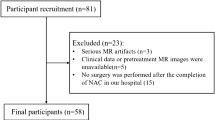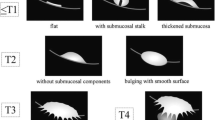Abstract
Objectives
To evaluate the diagnostic performance of DCE MRI and DWI in the assessment of pathologic complete response (pCR) after neoadjuvant chemotherapy (NAC) in patients with muscle-invasive bladder cancer (MIBC).
Methods
This prospective study included 90 patients with MIBC who finished NAC. Two radiologists independently assessed MRI for the determination of semi-quantitative parameters (wash-in rate and wash-out rate) and apparent diffusion coefficient (ADC) value. The correlation between pCR and wash-in rate, wash-out rate, ADC value were analyzed. The area under the ROC curve (AUC) was used to evaluate the diagnostic performance for detecting pCR. Inter-reader agreement was assessed using the ICC statistics.
Results
On cystectomy specimens, pCR was confirmed in (43.3%, 39/90). pCR is negatively correlated with wash-out rate (r = − 0.701, p = 0.01) and ADC value (r = − 0.621, p = 0.01). ADC value is positively correlated with wash-out rate (r = 0.631, p = 0.001). The diagnostic accuracy of ADC value (cut-off value: 0.911 × 10−3mm2/s) and wash-out rate (cut-off value: 0.677 min−1) in the identification of pCR was (92% for reader 1, 91% for reader 2), and (90% for reader 1, 88% for reader 2), respectively. The sensitivity, specificity for predicting pCR using ADC value + washout rate cut off values were 95.4%, 97.7% for reader 1, and 96%, 97% for reader 2, respectively. AUC was 0.981 for reader 1, 0.971 for reader 2. The overall reproducibility of the mean ADC value and wash out rate was excellent (ICC = 0.83–0.90). The ICC values for the mean ADC value, washout rate was 0.89 (95% CI 0.84–0.89) and 0.87 (95% CI 0.86–0.91), respectively.
Conclusion
Semi-quantitative parameter (wash-out) derived from DCE-MRI and ADC has the potential to assess the tumor’s complete pathologic response. The two parameters using together can offer the best possibility to identify complete response to NAC in MIBC.





Similar content being viewed by others
Abbreviations
- MIBC:
-
Muscle-invasive bladder cancer
- NAC:
-
Neoadjuvant chemotherapy
- DCE-MRI:
-
Dynamic contrast-enhanced magnetic resonance imaging
- DWI:
-
Diffusion-weighted image
- pCR:
-
Pathologic complete response
- RC:
-
Radical cystectomy
References
Krause FS, Walter B, Ott OJ, et al. 15-year survival rates after transurethral resection and radiochemotherapy or radiation in bladder cancer treatment. Anticancer Res 2011;31:985e990.
Rodel C, Weiss C, Sauer R. Trimodality treatment and selective organ preservation for bladder cancer. J Clin Oncol 2006;24:5536e5544.
Shipley WU, Kaufman DS, Tester WJ, et al. Overview of bladder cancer trials in the Radiation Therapy Oncology Group. Cancer 2003; 97:2115e2119.
Sandler HM, Mirhadi AJ. Current status of radiation therapy for bladder cancer. Expert Rev Anticancer Ther 2010;10:895e901.
Koga F, Yoshida S, Kawakami S, et al. Low-dose chemoradiotherapy followed by partial or radical cystectomy against muscle-invasive bladder cancer: An intent-to-treat survival analysis. Urology 2008; 72:384e388.
A. Meyer, R. Ghandour, A. Bergman, C. Castaneda, M. Wosnitzer, G. Hruby, M. Benson, J. McKiernan, The natural history of clinically complete responders to neoadjuvant chemotherapy for urothelial carcinoma of the bladder, J. Urol. 192 (2014) 696–701.
D. Robins, J. Matulay, M. Lipsky, A. Meyer, R. Ghandour, G. DeCastro, C. Anderson, C. Drake, M. Benson, J.M. McKiernan, Outcomes following clinical complete response to neoadjuvant chemotherapy for muscle-invasive urothelial carcinoma of the bladder in patients refusing radical cystectomy, Urology 111 (2018) 116–121.
P. Mazza, G.W. Moran, G. Li, D.J. Robins, J.T. Matulay, H.W. Herr, G.J. Decastro, J.M. McKiernan, C.B. Anderson, Conservative management following complete clinical response to neoadjuvant chemotherapy of muscle invasive bladder cancer: contemporary outcomes of a multi-institutional cohort study, J. Urol. 200 (2018) 1005–1013.
A.B. Alexa Meyer, P. Nichols, M. Kates, N. Hahn, Mark Schoenberg, and Trinity Bivalacqua SUO 2017: Inaccuracy of Clinical Staging after Neoadjuvant Chemotherapy for Muscle Invasive Bladder Cancer, (2017).
J.E. Husband, L.H. Schwartz, J. Spencer, L. Ollivier, D.M. King, R. Johnson, R. Reznek, S. International Cancer Imaging, Evaluation of the response to treatment of solid tumours – a consensus statement of the International Cancer Imaging Society, Br. J. Cancer 90 (2004) 2256–2260.
E.A. Eisenhauer, P. Therasse, J. Bogaerts, L.H. Schwartz, D. Sargent, R. Ford, J. Dancey, S. Arbuck, S. Gwyther, M. Mooney, L. Rubinstein, L. Shankar, L. Dodd, R. Kaplan, D. Lacombe, J. Verweij, New response evaluation criteria in solid tumours: revised RECIST guideline (version 1.1), Eur. J. Cancer 45 (2009) 228–247.
V. Kundra, P.M. Silverman, Imaging in the diagnosis, staging, and follow-up of cancer of the urinary bladder, Am. J. Roentgenol. 180 (2003) 1045–1054.
P. Ramchandani, H.M. Pollack, Radiology of drug-related genitourinary disease, Semin. Roentgenol. 30 (1995) 77–87.
Choi SJ, Park KJ, Lee G, Kim MH, Kim JK. Urothelial phase CT for assessment of pathologic complete response after neoadjuvant chemotherapy in muscle-invasive bladder cancer. Eur J Radiol. 2020;126:108902.
A. Soubra, M. Gencturk, J. Froelich, P. Balaji, S. Gupta, G. Jha, B.R. Konety, FDGPET/ CT for assessing the response to neoadjuvant chemotherapy in bladder cancer patients, Clin. Genitourin. Cancer 16 (2018) 360–364.
R.J. de Haas, M.J. Steyvers, J.J. Fütterer, Multiparametric MRI of the bladder: ready for clinical routine? Am. J. Roentgenol. 202 (2014) 1187–1195.
S. Verma, A. Rajesh, S.R. Prasad, K. Gaitonde, C.G. Lall, V. Mouraviev, G. Aeron, R.B. Bracken, K. Sandrasegaran, Urinary bladder cancer: role of MR imaging, RadioGraphics 32 (2012) 371–387.
C. Chakiba, F. Cornelis, E. Descat, M. Gross-Goupil, P. Sargos, G. Roubaud, N. Houede, Dynamic contrast enhanced MRI-derived parameters are potential biomarkers of therapeutic response in bladder carcinoma, Eur. J. Radiol. 84 (2015) 1023–1028.
Yoshida S, Koga F, Kawakami S et al. Initial experience of diffusion-weighted magnetic resonance imaging to assess therapeutic response to induction chemoradiotherapy against muscle-invasive bladder cancer. Urology 2010; 75: 387–91.
Yoshida S, Koga F, Kobayashi S et al. Role of diffusion-weighted magnetic resonance imaging in predicting sensitivity to chemoradiotherapy in muscle-invasive bladder cancer. Int. J. Radiat. Oncol. Biol. Phys. 2012; 83: e21–7.
- Wang HJ, Pui MH, Guo Y, Yang D, Pan BT, Zhou XH. Diffusion-weighted MRI in bladder carcinoma: the differentiation between tumor recurrence and benign changes after resection. Abdomen Imaging. 2014; 39:135–141.
Padhani AR, Liu G, Koh DM, et al. (2009) Diffusion-weighted magnetic resonance imaging as a cancer biomarker: consensus and recommendations. Neoplasia 11:102–125
-El-Assmy A, Abou-El-Ghar ME, Refaie HF, Mosbah A, El-Diasty T (2012) Diffusion-weighted magnetic resonance imaging in followup of superficial urinary bladder carcinoma after transurethral resection: initial experience. BJU Int 110:E622–E627
Pearson RA, Thelwall PE, Snell J, et al. Evaluation of early response to neoadjuvant chemotherapy in muscle-invasive bladder cancer using dynamic contrast-enhanced MRI and diffusion-weighted MRI: MARBLE study. J Clin Oncol 2016;34:403.
Dobson MJ, Carrington BM, Collins CD, et. al.: The assessment of irradiated bladder carcinoma using dynamic contrast-enhanced MR imaging. Clin Radiol 2001; 56: pp. 94-98.
Zhou G, Chen X, Zhang J, Zhu J, Zong G, Wang Z. Contrast-enhanced dynamic and diffusion-weighted MR imaging at 3.0T to assess aggressiveness of bladder cancer. Eur J Radiol. 2014;83(11):2013-2018.
Schrier BP, Peters M, Barentsz JO, Witjes JA. Evaluation of chemotherapy withmagnetic resonance imaging in patients with regionally metastatic or unre-sectable bladder cancer. Eur Urol 2006;49(4):698–703.
Donaldson SB, Bonington SC, Kershaw LE, Cowan R, Lyons J, Elliott T, et al.Dynamic contrast-enhanced MRI in patients with muscle-invasive transitionalcell carcinoma of the bladder can distinguish between residual tumour andpost-chemotherapy effect. Eur J Radiol 2013;82(12):2161–8.
Nguyen HT, Jia G, Shah ZK, et al. Prediction of chemotherapeutic response in bladder cancer using K-means clustering of dynamic contrast-enhanced (DCE)-MRI pharmacokinetic parameters. J Magn Reson Imaging. 2015 May;41(5):1374-82.
Nguyen HT, Mortazavi A, Pohar KS, Zynger DL, Wei L, Shah ZK, Jia G, Knopp MV. Quantitative Assessment of Heterogeneity in Bladder Tumor MRI Diffusivity: Can Response be Predicted Prior to Neoadjuvant Chemotherapy? Bladder Cancer. 2017 Oct 27;3(4):237-244.
Ciolina M, Caruso D, De Santis D, et al. (2019) Dynamic contrast-enhanced magnetic resonance imaging in locally advanced rectal cancer: role of perfusion parameters in the assessment of response to treatment. Radiol med 124:331–338
Seierstad T, Hole KH, Grøholt KK, et al. MRI volumetry for prediction of tumour response to neoadjuvant chemotherapy followed by chemoradiotherapy in locally advanced rectal cancer. Br J Radiol. 2015;88(1051):20150097.
Wang JZ, Mayr NA, Zhang D, Li K, Grecula JC, Montebello JF, et al. . Sequential magnetic resonance imaging of cervical cancer: the predictive value of absolute tumour volume and regression ratio measured before, during, and after radiation therapy. Cancer 2010; 116: 5093–101.
Disclosure
The scientific guarantor of this publication is DR: Shimaa Abdalla Ahmed. The authors of this manuscript declare no relationships with any companies, whose products or services may be related to the subject matter of the article.
Funding
No disclosure of funding received for this work from any organization.
Author information
Authors and Affiliations
Corresponding author
Ethics declarations
Conflict of interest
The authors declare that they have no conflict of interest.
Ethical approval
Institutional Review Board approval was obtained.
Informed consent
Written informed consent was obtained from all patients participating in the study.
Additional information
Publisher's Note
Springer Nature remains neutral with regard to jurisdictional claims in published maps and institutional affiliations.
Rights and permissions
About this article
Cite this article
Ahmed, S.A., Taher, M.G.A., Ali, W.A. et al. Diagnostic performance of contrast-enhanced dynamic and diffusion-weighted MR imaging in the assessment of tumor response to neoadjuvant therapy in muscle-invasive bladder cancer. Abdom Radiol 46, 2712–2721 (2021). https://doi.org/10.1007/s00261-021-02963-7
Received:
Revised:
Accepted:
Published:
Issue Date:
DOI: https://doi.org/10.1007/s00261-021-02963-7




